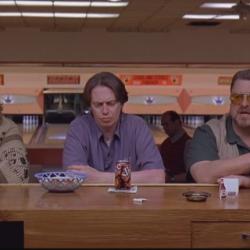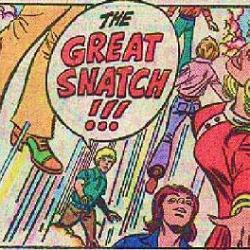Tribulation Force, pp. 445-450
Stymied by traffic jams and nuclear war, our heroes will be forced to hike half a mile on foot to reach the just-bombed hospital where their friend Bruce Barnes was lying in a coma.
“I’m going,” Rayford said.
“Me too,” Buck said.
“We’re all going,” Chloe insisted, but Rayford held up a hand.
Silly little girl, this is a man’s job.
“We’re not all going. It’s going to be hard enough for one of us to get past security. Buck or I will have a better chance because we have Global Community identification.”
What does “get past security” mean here? Is this part of the military response to the insurgency? Or are military checkpoints some previously unmentioned aspect of life in Nicolae Carpathia’s “Global Community”?
“I think one of us with an ID should go, and the other should stay with the wives. We all have to be with someone who can get past the red tape if necessary.”
“I want to go,” Buck said, “but you make the call.”
“Stay and make sure the car is positioned so we can get out of here and get to Mount Prospect. If I’m not back in half an hour, take the risk and come looking for me.”
Those GC ID cards are a nifty perk of being top-level employees of the Antichrist, ensuring that Rayford and Buck can always “get past the red tape.” (That totalitarian police state can be such a nuisance.) But you know what’s an even sweeter benefit from their jobs working for Nicolae? Not having to do them. We discussed Buck’s journalistic negligence last week, but Rayford is also remarkably unconcerned with having to check in with his boss. He’s in charge of Nicolae’s plane. Nicolae’s plane is being targeted for attack by insurgents. But he’s in no hurry to call the office.
“Daddy, if Bruce is any better, try to bring him with you.”
“Don’t worry, Chloe,” Rayford said. “I’m ahead of you.”
I think he’s a bit ahead of himself as well. Last he heard, Bruce was in a coma. It’s not clear, then, just how Rayford — alone and on foot — is planning on bringing Bruce back.
Buck, meanwhile, is chafing at not going along with his father-in-law. Just staying back and waiting is fine for “the wives,” but not for a manly person of action like himself. And, yes, Buck actually thinks of himself in exactly those words, “person of action”:
As soon as Rayford had jogged through the muddy weeds and out of sight, Buck regretted agreeing to stay behind. He had always been a person of action, and as he watched shell-shocked citizens milling about and commiserating, he could hardly stand still.
Reading that description of Buck Williams here — “a person of action” — makes me wonder if Jerry Jenkins remembers anything at all of what he typed in the previous 446 pages of Tribulation Force, or in all of the previous volume. In those hundreds of pages, the only evidence we’ve ever seen that Buck Williams is a “person of action” is from several scenes like this one, in which Buck sits passive and inert, but stews over how hard it is for him to do so because he’s “a person of action.”
Throughout these books, every time Buck fails or refuses or chooses not to act he mutters about how this angers him, because deep-down he knows himself to be a man of action. And the converse is also true: Every time we hear Buck congratulating himself for being a manly man of action, we see him failing or refusing or choosing not to act.
Rayford clears a hill and gets his first glimpse of the hospital:
Part of the full height of the structure was still intact, but much of it was rubble. Emergency vehicles surrounded the mess, with white-uniformed rescue workers scurrying about. A long stretch of police barrier tape had been stretched around the hospital campus. As Rayford lifted it to duck under, a security guard, weapon ready, ran toward him.
“Halt!” he called out. “This is a restricted area!”
For those keeping score, the following is a list of entities that remain armed after the implementation of the Antichrist’s global disarmament plan:
- Global Community “peacekeeping” forces (the OWG military);
- Israel — the one country still separate from the OWG;
- the former country of the United Kingdom;
- the former country of Egypt;
- several American “East Coast militias” (the Cambridge Regiment, the Suffolk County Reserves, the New Haven Patriot Corps, etc.);
- the security staff of Northwest Community Hospital in Arlington Heights, Ill.
One has to admire the efficiency of this hospital security staff. It’s only been a few hours since the building collapsed, but they refused to be distracted by the cries of the wounded and promptly sprang into action, stringing up an impressive amount of crime-scene tape, declaring the scene a “restricted area,” and guarding the perimeter against potential rescue workers or other intruders.
“I have clearance!” Rayford shouted, waving his ID wallet. …
“Wow! Clearance level 2-A. You work for Carpathia himself?”
Rayford nodded.
“What’s your job?”
“Classified.”
“Is he around here?”
“No, and I wouldn’t tell you if he was.”
I know what you’re thinking — Rayford only has clearance level 2-A? It doesn’t sound like it, but that’s actually the highest level. The only person with clearance level 1-A is Hattie Durham … if you know what I mean, nudge, nudge.
Rayford headed toward what had been the front of the building. He was largely ignored by people too busy to care who did or did not have clearance to be there. Body after body was laid out in a neat row and covered.
And here, just pages from the end of this book, we encounter the rarest of creatures in the Left Behind universe — actual human beings behaving as actual human beings. This includes the woman who is probably my favorite character so far.
An EMT tells Rayford that only three survivors have been found so far among the rubble, and Bruce was not among them:
[Rayford] strode to the makeshift outdoor morgue where several EMTs moved among the remains, lifting sheets and taking notes, trying to reconcile patient and employee lists with body parts and ID bracelets.
“Help or get out of the way,” a heavyset woman said as she brushed past Rayford.
See? I like her already. Her very first sentence is the one thing that desperately needed to be said to Rayford Steele 800 pages ago.
“I’m looking for a Bruce Barnes,” Rayford said.
The woman, whose nameplate read Patricia Devlin, stopped and squinted, cocked her head, and checked her clipboard. She flipped through the three top pages, shaking her head. “Staff or patient?” she asked.
This is intended, I think, to heighten the suspense over Bruce’s fate. That’s what the authors want us to be thinking about here: Bruce’s fate. They’ve just told us that Washington, D.C., and London have been destroyed with millions dead. Our hero is standing amidst the rubble of what used to be a hospital, where again hundreds of people have been killed. But the authors want us focused on Bruce, who here is supposed to play the role of those adorable dogs who miraculously survive in bad disaster movies.
But I can’t think about Bruce Barnes here. I’m far more interested in Patricia Devlin. Her very presence in this story means that she is one of the left behind, a “bad person” and an unforgiven sinner who deserves the wrath, punishment and suffering that Tim LaHaye’s God has planned for her. And nothing in her brief appearance suggests that she is, like Rayford, a “Tribulation saint” — meaning that in the authors’ view, she will be subjected to that wrath, punishment and suffering for all of eternity.
And yet here she is, keeping her head down and soldiering on in the face of unfaceable carnage and devastation. Rayford is there because his friend was one of the hundreds of people inside the hospital when it was struck. Patricia is there because hundreds of people were inside the hospital when it was struck. Rayford can leave as soon as he confirms what happened to his friend. Patricia won’t be leaving any time soon.
“Patient. Brought into the emergency room. He was in a coma last we heard.”
“Probably ICU then,” she said. “Check over there.” Patricia pointed to six bodies at the end of a row.
She’s brusque at first, because she doesn’t have time for this interruption. But after a few more pestering questions from Rayford, she softens, taking time she doesn’t have and can’t afford in order to show kindness to a stranger.
“If he’s out here, hon, he’s confirmed dead. If he’s still inside, they may never find him. … You want I should check for you?”
Rayford’s face contorted, and he could hardly speak. “I’d be grateful.”
Patricia Devlin moved quickly, surprisingly agile for her size. Her thick, white-soled shoes were muddy. She knelt by the bodies one by one, checking, as Rayford stood ten feet away, his hand covering his mouth, a sob rising in his throat.
Again, whatever suspense Jenkins intended here over the fate of Bruce Barnes is lost on me due to the unexpected puzzle of encountering a real human-seeming character in these pages — a real human-seeming character I actually kind of like.
Jenkins seems to have liked her too. It’s possible that was intentional — that Patricia Devlin is based on someone he knew and admired, and that she appears here as an affectionate tribute to some real-life friend or acquaintance of his. Or maybe she just showed up. Characters do that sometimes — they just introduce themselves and start talking and all the writer can do is race to write it all down. That’s happened to most writers at some point, but I wasn’t sure it would ever happen to Jerry Jenkins.
At the fourth body, Miss Devlin began to lift the sheet when she hesitated and checked the still-intact wristband. She looked back at Rayford, and he knew. …
“Could you check for a pulse?” Rayford managed.
“Oh, sir,” she said, deep sympathy in her voice, “they don’t bring them out here unless they’ve been pronounced.”
“Please,” he whispered, crying openly now. “For me.”
And as Rayford stood in the bluster of suburban Chicago’s early afternoon, his hands to his face, a woman he had never met before and would never see again placed a thumb and forefinger at the pressure points under his pastor’s jaw.
Without looking at Rayford, she took her hand away, replaced the sheet over Bruce Barnes’s head, and went back about her business.
And there is the difference between Miss Patricia Devlin and the other characters surrounding her in these books — she has business to attend to. She’s busy. She’s what a “person of action” actually looks like.
How fitting, then, that she should shoulder her way unexpectedly into this book in this particular scene in order to preside over the death of the hapless Bruce Barnes. Bruce should have been busy. Better than anyone else, he knew exactly what was coming. It was all clearly spelled out for him in the Rev. Billings’ notes — so clearly that there was no need for him to fritter away more than a year locked in Billings’ old office re-reading and re-re-reading those simple notes. Yet beyond the crudest of crude plans — dig a hole and hide — Bruce never got busy acting on what he knew.
“Help or get out of the way,” Patricia said. Bruce never did the former so here, at last, he does the latter.
After Patricia strides off in her thick — maybe even sensible — shoes, Jenkins reverts to form. He slathers on the bathos in the final two pages, still trying somehow to sadden us with the news of Bruce’s death while distracting us from the millions of other deaths he barely notes in passing. Rayford kneels among the carnage, weeping, but weeping only for one out of all the millions dead.
Rayford’s legs buckled, and he knelt on the muddy pavement. Sirens blared in the distance, emergency lights flashed all around him, and his family waited less than half a mile away. It was just him and them now. No teacher. No mentor. Just the four of them.
Manly men can still weep manly tears, you see. You can weep for a friend and still be a manly man, provided you still make sure “the wives” know their place.
Buck was nearly ready to go after Rayford when he saw a tall form appear on the horizon. From his gait and the slump of his shoulders, Buck knew.
“Oh, no,” he whispered, and Chloe and Amanda began to cry. The three of them rushed to meet Rayford and walk him back to the car.
The Red Horse of the Apocalypse was on the rampage.
That’s the final line in the book. It sounds wonderfully ominous if you don’t think about it much. The Red Horse of War is on the rampage — deadly, global, unending war.
But who, exactly, will be fighting this war? It still takes two to tangle, right? But the Brits and the Americans, the Russians, Ethopians and Egyptians have all been wiped out. Even the Upper West Side Militia has been neutralized. Apart from the Global Community military, the only army still around is Israel’s, and apparently the prophecy doesn’t allow the Antichrist to attack them for another 24 months. So how much of a war can the second seal bring if there’s no one left for Nicolae to fight?
The rider on the red horse seems to have galloped past while our heroes were stuck in traffic. It seems we plowed through 430+ pages of meetings, phone calls, job interviews, cookies, phone calls, romantic confusion, misogyny, plane travel and phone calls only to learn that instead of some serious John-the-Revelator-style devastation we’re only going to get one lousy seal, related to us second-hand and after-the-fact.
On the book jacket, we were promised this about our heroes: “Their task is clear, and their goal is nothing less than to stand and fight the enemies of God during the seven most chaotic years the planet will ever see.” But instead of fighting the enemies of God, they just secured themselves cushy little clearance-level-2A jobs with Enemies of God Inc., from which they then managed to be on vacation when finally, after hundreds of pages, the second seal hits the fan.
The actual task of the Tribulation Force seems to be killing time and running out the clock until the second Second Coming. That seems appropriate, since this book was written by two men whose belief system says that the primary task of Christians in the real world is killing time until the first Second Coming.
I feel like there should be more to say here at the end of Tribulation Force — that not providing some deeper insight at this milestone is woefully anticlimactic. But then, having waded through 450 pages of pointless treading water only to arrive here, maybe anticlimax is the most appropriate response.
– – – – – – – – – – – –
Next week is the holidays, so let’s plan to take that as a break from this series before returning in the new year with the direct-to-video epic movie adaptation of Tribulation Force. After that, it’s on to Book 3: Nicolae, in which I hope we don’t have to wait another 450 pages before we get to see some serious famine and pestilence.












